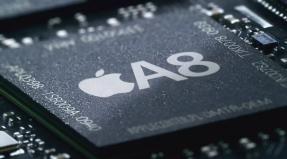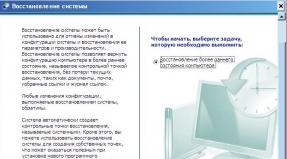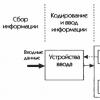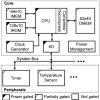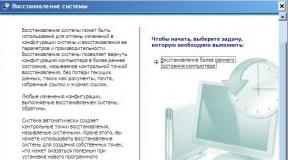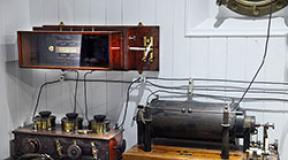Intermittent sound on laptop. Sound stutters on windows xp computer. Sound problem? Call! We will save your computer
If your sound stutters and wheezes when you start Windows, and there is also sound stuttering when playing music, minor freezes when playing video, short mouse freezes, then in most cases users begin to reinstall audio drivers, audio codecs and “do tricks with a tambourine.” It didn't work however.
Where and how to look for a problem
Click My computer on the desktop, right-click and select Properties. Click at the top Equipment and below device Manager.
Double-click on the channel on which the hard drive sits (usually the primary channel) and in the window that opens, click Extra options. Here we look at the data transfer mode, in most cases after a small load it resets to PIO, but should be DMA 5.
The same thing can happen with secondary channels where CD-ROMs sit
The fact is that if, when transferring data from a hard drive or CD drive, the system encounters a large number of errors, more than normal, then it switches the current mode to a slower one, i.e. PIO

And if this happens all the time, then the drivers (rarely a disk failure) of the SCSI and RAID controllers, which ensure data transfer, are most likely to blame.
This happens more often with JMicron controllers, which are installed on Asus, Msi motherboards... But, for some reason, on the official websites of the manufacturers of these motherboards you can download, to put it mildly, not the latest drivers.

So let's look at what kind of controllers we have. In this case, in the picture we see JMicron JMB 36x. It can be 362 and 363, etc., drivers are made for the entire series. You can find out more about controllers in the booklet included with the motherboard.
Well, then we move straight to the website of the manufacturer of these SCSI and RAID controllers. In my case, this is www.jmicron.com, and we download the latest drivers from there. If you haven’t found the manufacturer’s website, it doesn’t matter, the Internet is rich in any kind of firewood, just make a request in a search engine.
That’s basically it, we install new drivers, reboot the computer and understand that if the sound stutters and wheezes, then the problem is not always with the sound card.
http://site/wp-content/uploads/zaikaetsya-i-xripit-zvuk.jpghttp://site/wp-content/uploads/zaikaetsya-i-xripit-zvuk-150x150.jpg 2019-08-27T13:52:57+04:00 Windows problems, sound If your sound stutters and wheezes when you start Windows, and there is also a stuttering sound when playing music, minor freezes when playing video, short mouse freezes, then in most cases users begin to reinstall audio drivers, audio codecs and “do tricks with a tambourine.” It didn't work however. Where and how to look for the problem Click My...For 2.5 years of Windows 7 x64, no problems were observed with it. But when the computer was running for a long time, the music and sound being played began to be interrupted.
[link to audio file with interrupt example https://www.dropbox.com/s/t359z7tjnjbt45m/problem_... 1.44 MB]
This became especially noticeable when you launch a browser (absolutely any: Chrome, Firefox, Opera, of course the latest versions) and until all the tabs are updated, the melody wheezes and is interrupted; also when you open a new website or launch large software like photoshop"a, quarkxpress"a; and regardless of where you listen to music (from a hard drive or in a browser from websites). When communicating on Skype and the game is running at the same time, the interlocutor’s voice is also interrupted or disappears for a few seconds, as if the computer is reloading it. And at the same time, the processor load jumps by 100% on all 4 cores, the RAM fluctuates by 4.3Gb on average.
The problem is guaranteed to appear after playing games, for example: WoT or Diablo 3, etc. or after the client has been working for a long time on distributed computing (Folding@home).
There is a way to get rid of the problem - reboot the computer, but again it is temporary.
Long ordeals and experiments to identify the root of this evil-evil did not lead to anything.
At the program level the following was carried out:
+ diagnostics of RAM (memtest) and hard drives (Victoria and Intel utility): the result is excellent condition; the CrystalDiskInfo utility shows that there are no problems with the hard drives;
+ disable indexing of files on SSD;
+ disable hibernation;
+ changes the size of the paging file (in both directions);
+ all effects in the sound driver were disabled;
+ rearrangement of all drivers and firmware on ssd and BIOS;
+ tried to transfer and listen to music from different hard drives;
+ did a slight overclocking of the computer, as in the past it helped solve some glitches.
At the hardware level the following was carried out:
+ disabling all secondary hard drives;
+ complete disassembly of the computer for purging and removing dust, with replacement of the paste on the processor; there are no swollen capacitors;
+ replacing the power supply from 620W to 750W;
+ replacing a hard drive with 25k operating hours with a new one;
+ installation of an external sound card Asus Xonar DX.
Windows itself was also rearranged 3 times, from different distributions with and without updates.
At the moment, all that remains to be changed is the processor and the motherboard itself. If you have any suggestions or recommendations, I will be very happy to discuss.
Specifications:
Operating system: Microsoft Windows 7 Ultimate 6.1.7601.18409
CPU type: QuadCore Intel Core i5-750, 2800 MHz
Motherboard: Asus P7P55D-E
Video adapter: NVIDIA GeForce GTX 770
Built-in sound card: VIA VT1828S @ Intel Ibex Peak PCH - High Definition Audio Controller
External sound card: Asus Xonar DX
Disk drive: INTEL SSDSC2CW240A ATA Device (223 GB, IDE)
Disk drive: ST3500320AS ATA Device (500 GB, 7200 RPM, SATA-II)
Disk drive: WDC WD1002FAEX-00Z3A0 ATA Device (1000 GB, 7200 RPM, SATA-III)
Disk drive: WDC WD10EZEX-08M2NA0 ATA Device (1000 GB, 7200 RPM, SATA-III)
RAM: 12 GB =
2 sticks - Kingston HyperX KHX1600C9D3/4GX 4 GB DDR3-1600 DDR3
2 sticks - Kingston 9905403-125.A00LF 2 GB DDR3-1333 DDR3 SDRAM
Complete list of iron from Aida
A very common problem with sound, after its absence, is distortion: hissing, whistling, crackling, etc. It arises, naturally, as a result of updating the operating system or drivers for the sound card. Less commonly, the culprit is a virtual audio device. Today we’ll look at what to do if the sound on your computer stutters in Windows 10.
Checking the health of the audio playback device is the first step towards finding the cause of the problem. If the sound reproduction is unusual, speakers, headphones or an audio system should be disconnected from the computer/laptop and then reconnected.
It is also strongly recommended to check the functionality of the device on another computer or phone. If crackling and other distortions occur in this case, the problem lies in the hardware. Otherwise, the proposed article will become a reliable assistant in correcting the situation.
Audio effects may cause noticeable distortion in audio playback and should be disabled. Most likely, the audio stream passing through these filters turns out distorted.
1. Open the context menu of the “Speakers” icon located in the tray (through which we adjust the volume).
2. Select “Playback devices”.
3. Select speakers or an audio system, during playback on which the sound is interrupted or otherwise distorted.
4. Open the properties window by clicking on the button of the same name at the bottom of the window.

5. Go to the “Advanced” tab.
6. Uncheck the box next to the “Enable additional audio” option.

7. Go to “Additional Features” and check the “Disable all effects” option.

The same is done through the “Realtek HD Manager” if you are using a Realtek sound card and this utility is installed.
1. Open the context menu of the effects manager through its icon in the taskbar.
2. Click on the “Sound Manager” item.

3. In the “Sound Effect” tab, be sure to remove the checkboxes next to the “Loudness” and “Voice Suppression” options.
This will help if the sound on Windows 10 wheezes and hisses, or the quality of human voice reproduction has decreased significantly.

4. In the last tab “Standard format”, select “DVD format”, corresponding to studio quality: 24-bit audio with a sampling frequency of 48,000 Hz.

If there is no Realtek Manager or a different sound card is used, the audio format can be changed in the properties of the device used as a device for audio playback. In the “Advanced” tab, select studio recording with the parameters 24 bit and 48 kHz.

If the sound continues to be interrupted, hissing and distorted, try selecting other parameters.
Deactivating exclusive mode
At times, even with the latest drivers downloaded from the official resource, sound on a PC can be interrupted at any time for a split second when exclusive mode is enabled.
Check to see if the checkbox next to “Allow programs to use the device exclusively...” is unchecked.

Other settings that may affect audio playback
There is a function in Windows 10 that mutes all sounds when making audio and video calls through a browser or instant messengers. If the function is active, the volume will be reduced during conversations, and as a result, poor-quality sound may be heard.
In the speaker properties, go to the “Communication” tab and move the trigger to the “No action required” position.

Configuring playback devices
In the list of devices detected on the computer for playing sound, select the default one and click “Configure”. After this, a wizard will open with the parameters of the selected audio device.

Select your equipment type and test the sound for each speaker.
Reinstalling sound card drivers
If none of the above methods help resolve the cause of the problem, there are still several methods to do so. One of them is reinstalling the drivers for the sound card.
If you don’t know its manufacturer, go to “Device Manager” and in the “Sound, game, video devices” branch you will get this information.

1. Go to the driver developer’s resource and download its latest version (for Realtek, follow the link https://www.realtek.com/zh-tw/downloads).

2. Launch the installer and follow all instructions.
3. Once the installation is complete, restart the computer.
1. Call Device Manager via Win→X.
2. We expand the branch with sound and other gaming devices.
3. Using the device’s context menu, call the command to update its driver.

4. Specify the automatic type of search for the latest software versions on the Internet.

5. Upon completion of downloading, copying files and registering them, be sure to restart the computer
The second method, despite Microsoft's strong recommendation, is not recommended. Windows 10 loads drivers from the software giant's resources, and often such software is, if not outdated, then less suitable for the device than created by its developer. And using such software can bring a lot of problems.
additional information
Let's look at a couple of important aspects regarding sound problems in Windows 10.
- An installed program for capturing streaming audio or applying effects to sound can cause problems. If they appear after installing such applications, remove them from startup, or better yet, remove them altogether.
- Along with incorrect sound playback and slowdown, is Windows 10 itself buggy? Check the system for viruses, and through the Task Manager, make sure that no process is loading the CPU at 70 percent or more, and that the processor has free resources for normal audio decoding and OS operation.
- If the audio is distorted on a virtual machine or emulator, it is unlikely that the problem will be corrected. Like all software, emulators and virtualization tools are imperfect.
Windows 7 is considered one of the most stable operating systems ever produced by Microsoft. For this reason it enjoys well-deserved popularity among users. According to statistics, the “seven” ranks first in the ranking of desktop and laptop users.
Nevertheless, it is not free from various kinds of “glitches”. There are some problems with sound. Sometimes hissing and wheezing begins to be heard from the speakers, and the sound itself is constantly interrupted (it begins to stutter). Listening to music or watching movies in such an environment becomes almost impossible. This article is dedicated to the fight against such stuttering.
There are several reasons for this behavior of the sound subsystem. The first group of reasons includes hardware problems. The second is software failures. We list some of the reasons for failures:
- Failure of the computer sound card.
- Problems with non-native drivers.
- Incorrect connection to speaker or headphone adapter.
- Incorrect choice of playback mode in the operating system settings.
How to restore normal sound?
First of all, check how tightly the speaker or headphone plug is inserted into the sound card socket, and whether the connector is used. The speaker pin connector is usually green.
To test your sound card, you can use the RightMark Audio Analyzer program or something similar. Using the Everest utility, you can scan all your computer hardware and accurately determine the adapter model - perhaps the drivers you installed do not quite fit the computer card.
In the settings of the “seven”, delete the secondary IDE channel. You can do this by opening the device manager (“Control Panel” => “System and Security” => “System” => “Device Manager”). The secondary channel is located in the “IDE ATA/ATAPI” section. Right-click on its name and select “Delete” from the menu that opens. Sometimes it works only the second time. To fine-tune the sound, download and install the SRS Audio Sandbox program - with its help it’s easy to fix the problem.
After updating the operating system to the latest version, many PC and laptop users wondered why the sound stutters on a Windows 10 computer.
Often this problem occurs when installing drivers that are incompatible with Windows 10 or when specifying incorrect settings. The BIOS, or rather active settings that affect the operation of the sound card, can also be the culprit of the problem. Therefore, to solve the problem when, when playing tracks, the sound stutters for 1-3 seconds with varying frequency, you should use the following recommendations.
Updating drivers as a method to solve the problem
After the release of Windows 10, many motherboard manufacturers did not bother to release compatible drivers for their older products running the new OS. Therefore, Microsoft has released its own software for such products. Universal drivers do not always work correctly on older PCs. In addition, even if the network has up-to-date software, drivers from Microsoft are installed first.
- Right-click on the Start icon and select Device Manager.
- A new window will open. We find the branch “Sound, gaming and video devices”.
- Next, select the audio device. Right-click on it and select “Update Driver”.

- Select “Search for drivers on this PC.”

- You need to specify the path to the driver downloaded from the official website of the motherboard or sound card manufacturer. And follow the instructions of the installer wizard. Or click “Select a driver from the list of already installed ones.”

- The next step is to select a device that supports “High Definition Audio”.

- We are waiting for the system to install the software. Reboot the system and check if the sound stutters.
If the sound continues to stutter, you should try running automatic driver installation. To do this, just download the Driver Booster program, run it on your PC, then go to the “Outdated Drivers” tab and select “Update” sound driver.”

After the update, reboot the system again for the changes to take effect.
Adjusting sound settings
If the sound continues to stutter after updating the drivers, then the problem lies in the sound settings. They need to be corrected. To do this, do the following:
- Click on the volume icon located on the system tray. Select "Open Volume Mixer".

- A small window will appear. You need to set the sound level at the same level for PC and applications.

- Next, go to the “Control Panel”, select “Sound”.

- A window will open. Go to the “Advanced” tab. Here you need to uncheck the “Enable additional tools...” item. You also need to set the sound format to “16 bit, 48000 Hz”.

- After saving these settings, you should reboot the system.
Manipulating the BIOS to solve the problem with sound stuttering
On the official Microsoft forum, if problems with stuttering sound occur, they recommend performing the following settings in the BIOS:
- Booting into BIOS.
- We find and disable options such as C1E and EIST. If the BIOS has the HPET function, then it must be enabled by selecting the system bit size.
- We save the changes in the BIOS.
- Boot into Windows Launch a command prompt with administrator rights and enter “bcdedit /set (default) disabledynamictick yes” (without quotes), and then “bcdedit /set (default) useplatformclock true”.
- Reboot the PC.
If your sound still stutters, try installing old drivers in compatibility mode with the new 10. Perhaps this action will help solve the problem.
Read also...
- Home phone from MGTS: tariffs and additional services MGTS tariff plan 1
- How to use the latest version v2
- The best free programs for scanning documents
- Review of Meizu MX4 Pro - Android flagship from the Middle Kingdom Bluetooth is a standard for secure wireless data transfer between various devices of different types over short distances
